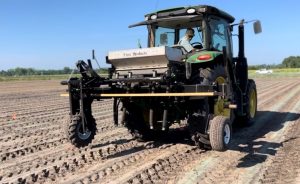Snap bean is a significant legume crop cultivated for its immature pods, with the U.S. accounting for 71% of global production. The crop is also a popular grocery commodity due to its vitamins, high protein, and dietary fiber. Legumes are generally efficient in nitrogen fixation; however, snap beans exhibit comparatively lower nitrogen fixation capacity.

With this in mind, effective nitrogen (N) fertilization is especially important in snap bean production. It plays a critical role in maximizing yields, particularly in sandy soils with low organic matter. While conventional N fertilizer sources are readily available to plants, they can lead to significant losses through leaching, contributing to environmental issues. Controlled-release fertilizers (CRFs) offer a potential solution. Those align nutrient release with crop demand, potentially improving nutrient use efficiency and reducing losses. In Florida, snap bean production exceeds 20 million pounds annually, making it a major agricultural commodity.
Objective
This study aims to compare conventional and controlled-release nitrogen sources applied at different rates and using different methods (broadcasting and banding) to determine the best practices for enhancing snap bean productivity in North Florida. The two nitrogen sources included conventional ammonium nitrate and controlled-release urea across five different application rates. Additionally, the trials aimed to compare two distinct application methods, broadcasting and banding. By assessing these variables, the trials seek to determine the best N fertilization strategies to maximize snap bean yield and quality in North Florida. The trials also aim to enhance nutrient use efficiency, reduce potential nutrient losses to leaching, and align fertilization practices with the specific growth needs of snap beans. Overall, the findings will contribute to improved agricultural practices that support sustainable snap bean production in the region.

Treatments
These trials were conducted at the North Florida Research and Education Center-Suwannee Valley, with both years’ sites following a strong legume crop (peanuts). The trial used a randomized complete block design with four replications, resulting in 40 plots and 10 treatments. These treatments combined five nitrogen (N) application rates (0, 50, 100, 150, and 200 lbs/acre) with two N sources, conventional ammonium nitrate and controlled-release urea. The trials used the snap bean cultivar ‘Caprice’, and one controlled-release fertilizer treatment at 100 lbs/acre used both banding and broadcasting methods. Conventional N was applied in three split applications, at planting and followed by two side-dress applications during the growing season. The trials measured various factors, including yield and pod quality, to determine the best N fertilization strategies for snap beans in North Florida.
Conventional and CRF Nitrogen(N) fertilizer treatments implemented for snap bean evaluation in 2021 & 2022.
| N Source | Rate (lbs/acre) | Method of Application | Treatment |
|---|---|---|---|
| Control | 0 | ~ | Control-0 |
| Controlled-Release Fertilizer | 50 | Banded | CRF-50 |
| 100 | Banded | CRF-100 | |
| 150 | Banded | CRF-150 | |
| 200 | Banded | CRF-200 | |
| Conventional Fertilizer (i.e., ammonium nitrate) | 50 | Banded | Conv-50 |
| 100 | Banded | Conv-100 | |
| 150 | Banded | Conv-150 | |
| 200 | Banded | Conv-200 | |
| Broadcast Controlled-Release Fertilizer | 100 | Broadcasted | CRF-Br-100 |
Results

This study observed the effects of various nitrogen (N) sources as well as application rates and methods on the yield and quality of snap beans over two growing seasons. Results indicated that all N treatments significantly enhanced yields at all rates (50, 100, 150, 200) above 0 lbs/acre. The current recommended nitrogen rate for snap beans in Florida is 100 lbs/acre. In this study, it is suspected that the 50 lb. rate was similar to all other rates because of the potential contribution of nitrogen from the peanut(legume) crop in the previous year on the research sites. Both controlled-release nitrogen fertilizer and conventional nitrogen fertilizer showed a similar performance, and there were no significant differences in yield. In terms of quality, pod length improved in 2022 compared to 2021, but differences in treatments were minimal, indicating that factors like weather and soil conditions also played a major role. This research provides valuable insights for improving nutrient management practices in snap bean production, especially when following a legume in the sandy soils of the Suwannee Valley.

Best Management Practices – Nitrogen Fertilizer on Snap Beans after Legumes in the Suwannee Valley
Authors: Sydney Williams, Bob Hochmuth, Taite Miller, Rajkaranbir Singh, Diego Arruda Huggins de Sa Leitao, and Lakesh K. Sharma
University of Florida, Institute of Food and Agricultural Sciences
North Florida Research and Education Center- Suwannee Valley
7580 County Road 136 Live Oak, FL 32060
 5
5
